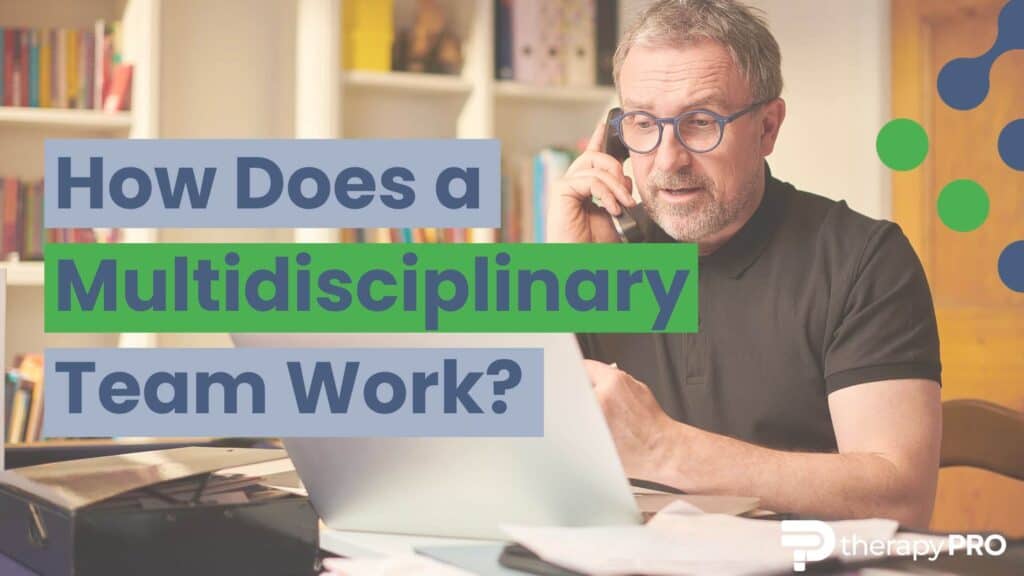How Does a Multidisciplinary Team Work?
Starting therapy can sometimes feel like a complicated journey, filled with many decisions, but it doesn’t have to be.
A multidisciplinary team (MDT) offers a holistic care approach that provides comprehensive support tailored to the person.
In this article, we’ll explore how an MDT works and the benefits it brings, helping you feel more prepared as you begin your therapy journey – or as you support a loved one on their journey.
We also share an example of an MDT in action, supporting a child, to show you what holistic care can look and feel like.
What is a Multidisciplinary Team?
A multidisciplinary team (MDT) is a group of different professionals who work together to help you, your loved one, or your client.
Each person in the team has special skills and knowledge, ensuring all aspects of the person’s health and wellbeing are addressed.
Common members of an MDT include occupational therapists (OTs), psychologists, speech and language pathologists (SLPs), social workers, and positive behaviour support (PBS) practitioners.
By bringing together their expertise and experiences, MDTs develop and implement a coordinated therapy plan that addresses the client’s physical, emotional, and social needs.
This approach ensures that no aspect of the client’s wellbeing is overlooked. This is often referred to as a holistic therapy plan.
What Does a Multidisciplinary Team Do?
An MDT takes a collaborative approach to therapy, working together to create a therapy plan.
Each team member contributes their specialised skills to address different aspects of the client’s needs.
For example:
- Occupational therapists focus on helping clients develop or regain the skills needed for daily living and working.
- Psychologists provide mental health support, including therapy for emotional and psychological issues.
- Speech and language pathologists assist with communication disorders, helping clients improve their speech, language, and swallowing abilities.
- Social workers offer support with social and environmental challenges, connecting clients with community resources and support systems.
- Positive behaviour support practitioners work on strategies to improve behaviours and enhance the client’s quality of life.
These professionals work together to assess the client’s needs, set goals, and monitor progress.
This collaborative approach ensures that all aspects of the client’s needs are addressed, leading to more effective and efficient treatment outcomes.
What is an Example of a Multidisciplinary Team?
Let’s look at a story involving an MDT.
Imagine a child named Liam. Liam is eight years old and has developmental delays, which means he needs help in different areas to help in different areas to meet goals that his family have identified as priorities. His parents want to make sure he gets the best support, so they reach out to a therapy provider who offers MDT services.
Here’s how each professional helps Liam:
Liam’s OT, Sarah, helps him improve his fine motor skills. She works with Liam on tasks like writing, tying his shoes, and dressing himself. Sarah makes these activities fun by turning them into games Liam enjoys.
Dr. Mike, the psychologist, helps Liam with his emotions and behaviour. Liam sometimes gets frustrated easily and has trouble expressing his feelings. Dr. Mike teaches Liam ways to manage his emotions and communicate better with his friends and family.
Liam’s SLP, Emma, works on his communication skills. Liam has trouble pronouncing words clearly and sometimes struggles to understand others. Emma uses interactive activities and games to help Liam to communicate more easily with people around him.
Anna, the social worker, helps Liam’s family find resources and support in their community. She connects them with local support groups, educational programs, and other services that can help Liam and his family.
The PBSP, John, designs strategies to help Liam make positive behaviour choices by investigating and modifying his environment. He works with Liam and his parents to create a supportive environment at home and school, making it easier for Liam to succeed in his daily activities.
Together, this team creates a personalised therapy plan for Liam that looks after all his needs. They meet regularly to discuss his progress and make sure they are all on the same page. They also involve Liam’s parents, teachers, and caregivers to ensure everyone is working together to support Liam’s development.
With the help of his MDT, Liam starts making great progress. He becomes more confident in his abilities, communicates better, and finds it easier to manage his emotions. His family feels supported and hopeful as they see Liam thrive with the care provided by his MDT.
What is the Primary Role of the Multidisciplinary Team?
The primary role of an MDT is to ensure comprehensive care by addressing all aspects of a client’s health and wellbeing.
This may involve:
Assessment
Each team member considers the client’s strengths and challenges from their professional perspective. Sometimes this includes formal assessment and at other times the team member may get more information from those that know the client best or observations in everyday situations.
For instance, an occupational therapist might assess a client’s ability to perform daily activities, while a psychologist might look at their emotional wellbeing.
Once each team member has been able to develop a profile of strengths and difficulties, the team can work together to get a holistic picture of the client and their support network.
Goal Setting
The team collaborates to set realistic and achievable goals based on the client’s needs and desired outcomes.
This process involves discussing what the client hopes to achieve and setting measurable targets.
For example, if a client wants to improve their communication skills, the speech and language pathologist will outline specific milestones to reach that goal, with input from the rest of the team to ensure these goals are holistic and attainable.
Therapy Goals and Planning
Developing a coordinated and personalised therapy plan that integrates the interventions and supports from all team members is a core part of any therapeutic support service.
The plan outlines each team member’s role and the specific interventions they will provide. It ensures that all aspects of the client’s care are covered and that the interventions work together smoothly.
For example, a therapy plan for a child with autism might include speech therapy sessions, behavioural interventions, and support for the parents.
Plan Implementation
Each professional carries out their part of the therapy plan, working in harmony with the rest of the team.
This means that while the occupational therapist is helping the client with daily tasks, the psychologist might be providing mental health support, and the speech therapist might be working on communication skills.
All these activities are coordinated to ensure they complement each other and avoid any overlap or gaps in care.
Monitoring and Evaluation
Regularly reviewing the client’s progress and making necessary adjustments to the therapy plan is a crucial step. This ensures that the client is making progress and that the interventions are effective.
The team meets regularly to discuss the client’s progress, any challenges they are facing, and any changes that need to be made to the therapy plan.
This ongoing evaluation helps keep the client’s care on track and ensures that they are moving towards their goals.
Benefits of a Multidisciplinary Team Approach
The MDT approach offers numerous benefits.
An MDT provides a more holistic approach to care because it addresses all aspects of a client’s needs. Although we’ve given examples of teams with many therapists, an MDT is comprised of only the therapies the individual client requires.
MDT care is comprehensive, covering everything from physical needs to emotional wellbeing. This collaborative care often leads to better health outcomes, as all aspects of the client’s needs are considered. When care is coordinated, clients tend to achieve their goals more effectively and efficiently.
MDTs tailor their approach to the individual needs of the client, ensuring personalised care. This client centred support means that therapy plans are specifically designed to meet the unique needs of each client, making the care more effective and engaging for the client.
Regular communication between MDT members reduces the risk of gaps in care and ensures that everyone is working towards the same goals. This allows for seamless transitions between different types of therapy and consistent monitoring of the client’s progress.
For instance, if a client’s needs change, the team can quickly adapt the therapy plan to address these new challenges, ensuring continuous and effective support.
What to Look for in a Service to Ensure an MDT Approach
Here are some tips to follow when seeking an MDT to provide you, a family member, or your client with holistic care:
- Ask about the team – enquire about the professionals involved in the care team and their qualifications.
- Look for coordination points – ensure that the service has a system in place for regular team meetings and coordinated therapy planning.
- Check for different services – good MDTs should offer a range of therapies, including, but not limited to occupational therapy, psychology, speech and language pathology, social work, and positive behaviour support.
- Client-centred approach – this means support is personalised to the client, (it’s not a cookie-cutter, one-size-fits-all approach), which is at the heart of MDTs.
Wrapping Things Up
The multidisciplinary team approach in therapy provides a holistic, comprehensive, and client-focused way to meet various health and wellbeing needs.
By bringing together the expertise of different professionals, an MDT ensures that every aspect of a clients’ needs are thoughtfully considered and treated.
If you’re looking for therapy services for yourself, your loved one, or a client, consider the benefits of an MDT, and seek out a provider that embraces this collaborative approach.
Contact us to find out about our MDT support services:




